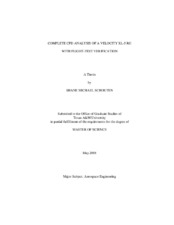| dc.contributor.advisor | Saric, William S. | |
| dc.creator | Schouten, Shane Michael | |
| dc.date.accessioned | 2008-10-10T20:54:50Z | |
| dc.date.available | 2008-10-10T20:54:50Z | |
| dc.date.created | 2008-05 | |
| dc.date.issued | 2008-10-10 | |
| dc.identifier.uri | https://hdl.handle.net/1969.1/85894 | |
| dc.description.abstract | The Texas A&M Flight Research Laboratory (FRL) recently received delivery of its
newest aircraft, the Velocity XL-5 RG. The Velocity can fly faster than the other aircraft
owned by the FRL and does not have a propeller in the front of the aircraft to disrupt the
air flow. These are definite advantages that make the Velocity an attractive addition to
the FRL inventory to be used in boundary-layer stability and transition control. Possible
mounting locations built into the aircraft for future projects include hard points in the
wings and roof of the fuselage. One of the drawbacks of the aircraft is that it has a
canard ahead of the main wing that could disrupt the incoming flow for a wing glove or
research requiring test pieces mounted to the hard point in the wing. Therefore, it is
necessary to understand the influence the canard and the impact of its wake on the wing
of the aircraft before any in-depth aerodynamic research could be completed on the
aircraft.
A combination of in-flight measurements of the canard wake and Computational
Fluid Dynamics (CFD) were used to provide a clear picture of the flowfield around the
aircraft. The first step of the project consisted of making a 3-D CAD model of the
aircraft. This model was then used for the CFD simulations in Fluent. 2-D, 3-D, inviscid,
and viscous simulations were preformed on the aircraft. A pressure rake was designed to
house a 5-hole probe and 18 Pitot probes that extended forward of the main wing to
measure the location and strength of the canard wake at various flight conditions. There
were five primary test points that were recorded at multiple times over the course of three flights. Once all of the data were collected from the flights, the freestream
conditions became the inputs into the final, 3-D CFD simulations on the aircraft.
The good agreement between the CFD results and the in-flight measurements
provided the necessary verification of the CFD model of the aircraft. These results can
be used in the future planning and execution of experiments involving the Velocity XL-5
RG. | en |
| dc.format.medium | electronic | en |
| dc.language.iso | en_US | |
| dc.publisher | Texas A&M University | |
| dc.subject | CFD | en |
| dc.subject | flight-test | en |
| dc.subject | wind tunnel tests | en |
| dc.subject | Cimcore Coordinate Measurement Machine | en |
| dc.subject | Velocity XL-5 RG | en |
| dc.title | Complete CFD analysis of a Velocity XL-5 RG with flight-test verification | en |
| dc.type | Book | en |
| dc.type | Thesis | en |
| thesis.degree.department | Aerospace Engineering | en |
| thesis.degree.discipline | Aerospace Engineering | en |
| thesis.degree.grantor | Texas A&M University | en |
| thesis.degree.name | Master of Science | en |
| thesis.degree.level | Masters | en |
| dc.contributor.committeeMember | Bowersox, Rodney | |
| dc.contributor.committeeMember | Collins, Don | |
| dc.type.genre | Electronic Thesis | en |
| dc.type.material | text | en |
| dc.format.digitalOrigin | born digital | en |


